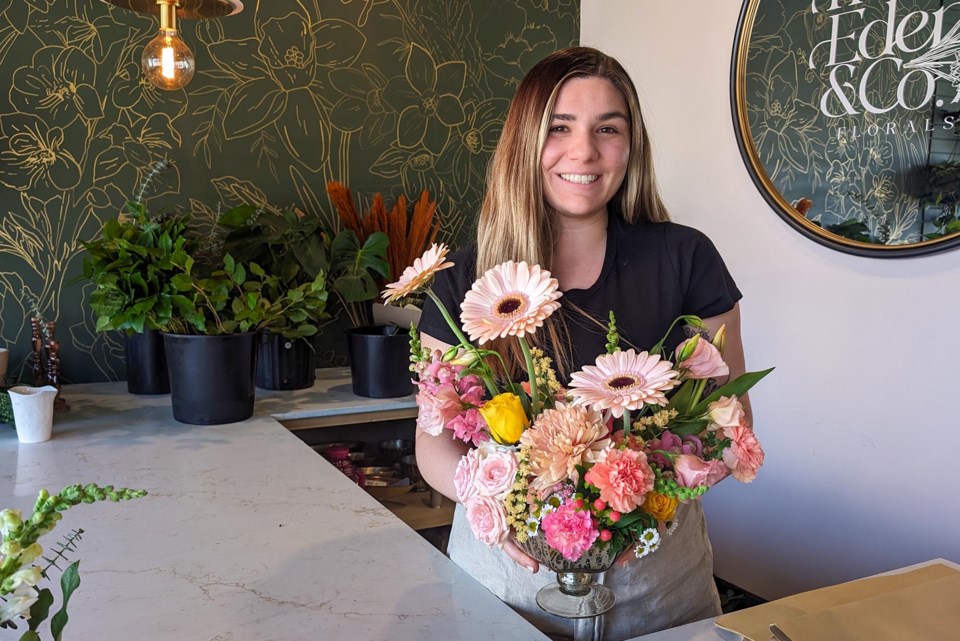When picking out flowers for a lover on Valentine’s Day, the most popular choice is a bouquet of red roses with greenery and a dash of Baby’s Breath. Or, for the last-minute crowd, Pelham florist Allison Paterson says the next best choice is a mixed bouquet.
“A red rose is the most typical choice, or if guys are more last- minute, it’s usually whatever arrangements we have left over.”
The florist, who owns the recently opened From Eden & Co. flower shop on Highway 20, said traditionally a flower’s colour has a specific meaning. Red roses signify passion and love, yellow means friendship, pink for happiness, and green for renewal and rebirth. However, Peterson said she thinks that tradition isn’t as popular as it used to be.
“Lots of people are choosing different colours like bright pink roses, quicksand roses, which are a lighter shade of pink, and even white or yellow,” Paterson said. “I don’t really think it matters what colours are supposed to represent as long as you like them.”
As for why lovers choose to give their partners flowers, chocolates and other gifts on Valentine’s Day, it’s all in the name of St. Valentine. According to Brock University Professor Katharine von Stackelberg, who teaches Ancient Environment, Latin and Roman history, said the true origins of St. Valentine has been widely debated. She explained there are many stories claiming that the real St. Valentine was a priest or bishop in Rome and was martyred in the third century.
“We have a lot of evidence and information but none of it really adds up. We do know there was a St. Valentine and there’s actually differing accounts and maybe up to three people who sort of make up the composite legend of the. St. Valentine that we know today.”
Von Stackelberg said the likely story is that there were multiple St. Valentines who died on or around Feb. 14, and were later canonized in the fifth century.
Modern day Valentine’s Day celebrations may also have roots in the Lupercalia festival, which was traditionally held on Feb. 15. The reasons for the ancient rites aren’t totally clear, but von Stackelberg said it was likely related to good fertility and health. The festival began with an animal sacrifice, followed by the Feast of Lupercal.
“What would happen is a goat would be ritually sacrificed and the skins would be cut up into thongs. The sources are conflicting but nude or nearly naked men would run around the sacred boundaries of Rome and they would strike women with those bloody strips of goats,” she said. “It was considered very lucky if you as a woman were struck by one of the thongs. If a woman got hit by one of these, it meant you had improved chances of getting pregnant and having a safe birth.”
Von Stackelberg said the beginning of Valentine’s Day as it’s known today comes from the 14th century, when English poet Geoffrey Chaucer wrote Parliament of Fowls, which is known as one of the earliest Valentine’s Day poems. It’s a 699-line poem about birds choosing their mates
“He basically says on this day, Valentine’s Day, this is the day that all birds in nature choose their mates. So that’s really the first moment we have a recorded tradition where Valentine’s Day is associated with love and pairing off.”
By the 16th century, the tradition was for a man to give practical gifts such as lengths of cloth or a pair of gloves in exchange for a kiss from a woman. Von Stackelberg explained this exchange didn’t necessarily have any romance involved.
“The first person you see in the morning of Valentine’s Day is your Valentine. This applies even if you’re married to someone else. Your Valentine would only be that for the morning.”
By the early 19th century, the Victorians introduced the sentimental aspect to Valentine’s Day, when they began giving cards to their sweethearts.
“This is where the modern idea of gift-giving comes in and the gifts are now no longer gloves, lengths of cloth or domestic goods. They’re supposed to be something small and delicate and ephemeral,” von Stackelberg said.“This is where the idea of flowers is established as a love language.”
The professor said pictures of flowers were usually given rather than actual flowers because there weren't many flowers available in February. It’s only when refrigeration technology in the late 19th and early 20th centuries allowed large-scale transportation of flowers from warmer areas to cooler areas of the country.
“It’s also around this period that hybrid tea roses are in development, which is basically where our long-stemmed American Beauty rose comes from, which is your standard Valentine rose,” von Stackelberg said.



